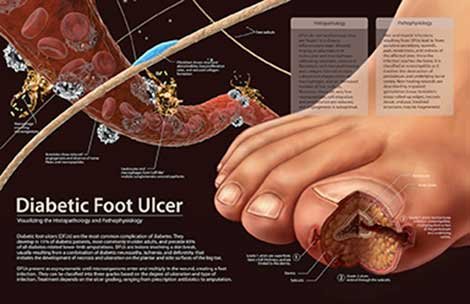When people hear about diabetes leading to someone losing their foot, it can sound scary and confusing. Why does this happen? The truth is that diabetes affects the body in ways that slowly damage blood flow and nerves, especially in the feet. Over time, these problems can make it harder for the body to heal even small cuts, which sometimes leads to serious infections. If those infections can’t be treated, doctors may need to remove, or amputate, part of the foot or leg to save the person’s life. Let’s break this down step by step in very simple terms.
How Diabetes Affects the Body
 Diabetes is a condition where the body has too much sugar (glucose) in the blood. Over time, high blood sugar damages the tiny blood vessels and nerves throughout the body. This is why doctors warn people with diabetes to keep their blood sugar under control.
Diabetes is a condition where the body has too much sugar (glucose) in the blood. Over time, high blood sugar damages the tiny blood vessels and nerves throughout the body. This is why doctors warn people with diabetes to keep their blood sugar under control.
Two main problems happen in the feet:
- Nerve Damage (Neuropathy): High sugar levels damage the nerves. This causes tingling, burning, or numbness in the feet. Because of numbness, a person might step on something sharp or develop a blister and not even feel it.
- Poor Circulation (Peripheral Artery Disease): Diabetes makes blood vessels narrow and stiff. Less blood reaches the feet, which means less oxygen and nutrients are available for healing. A small wound that would normally heal in days might linger for weeks or months.
Why Feet Are at Risk
The feet are far from the heart, which makes them harder to supply with strong blood flow. Combine that with shoes, walking, and pressure points, and the feet are easily injured. When you add in nerve damage, people with diabetes often don’t notice problems until they become serious.
Common issues include:
- Cuts, scrapes, or blisters that don’t heal
- Ingrown toenails or fungal infections
- Pressure sores or ulcers on the bottom of the foot
If these small problems aren’t treated quickly, they can turn into larger wounds.
The Role of Infections
One of the biggest reasons people get their feet cut off from diabetes is infection. Here’s how it usually happens:
- A cut or sore appears on the foot.
- Because of nerve damage, the person doesn’t notice it right away.
- Poor circulation prevents healing.
- Germs enter the wound, causing an infection.
- The infection spreads deeper into the skin, muscle, or even bone.
When infections reach this point, antibiotics alone may not be enough. If the infection threatens the person’s life, doctors may have no choice but to remove the infected part of the foot or leg. This is called amputation.
Signs a Diabetic Foot Problem Is Serious
It’s important to catch foot problems early. Warning signs include:
- Redness, swelling, or warmth in the foot
- Open sores or ulcers that do not heal
- Black or blue skin, which can mean tissue death (gangrene)
- Pus or foul smell coming from a wound
- Severe pain, or on the flip side, complete numbness
Anyone with diabetes who notices these symptoms should see a doctor immediately.
How Amputation Helps
Although amputation sounds frightening, it can sometimes save a person’s life. Removing the infected or dead tissue prevents infection from spreading through the bloodstream, which could be deadly. In many cases, doctors try to remove only the smallest amount possible, like a toe or part of the foot, to allow the person to walk again with proper shoes or prosthetics.
How to Prevent Amputation With Diabetes
The good news is that most amputations can be prevented. Here are some key steps:
- Control Blood Sugar: Keeping blood sugar levels in a healthy range reduces nerve damage and circulation problems.
- Check Feet Daily: Look for cuts, blisters, swelling, or color changes. Use a mirror to see the bottoms of your feet if needed.
- Wear Proper Shoes: Shoes should fit well and protect the feet. Avoid walking barefoot, even indoors.
- Keep Feet Clean and Dry: Wash daily, dry carefully (especially between toes), and apply moisturizer to prevent cracking.
- Trim Nails Safely: Cut straight across and file edges. If vision or flexibility is a problem, ask a podiatrist (foot doctor) for help.
- Quit Smoking: Smoking makes circulation worse and raises the risk of amputation.
- Regular Doctor Visits: A podiatrist can spot issues before they turn serious. People with diabetes should have their feet checked at least once a year, and more often if they already have problems.
Real-Life Example
Imagine this: John has type 2 diabetes. One day he gets a blister from a tight shoe. Because his nerves are damaged, he doesn’t feel it. Weeks go by and the blister becomes an open sore. Poor circulation slows healing, and bacteria infect the wound. Antibiotics don’t stop the infection because blood flow is too weak. By the time John seeks medical care, the infection has reached the bone. To save John’s life, doctors amputate his toe. If he had noticed the blister early and seen a doctor, the amputation could have been avoided.
Final Thoughts
So, why do people get their feet cut off from diabetes? It comes down to a chain reaction: high blood sugar damages nerves and blood vessels, small wounds go unnoticed, healing slows, infections spread, and sometimes amputation becomes the only option.
The most important message is this: with good care and daily attention, many of these amputations are preventable. People with diabetes who actively manage their condition, check their feet, and seek medical help early can greatly reduce their risk of losing a foot. Awareness and prevention truly save lives—and feet.
